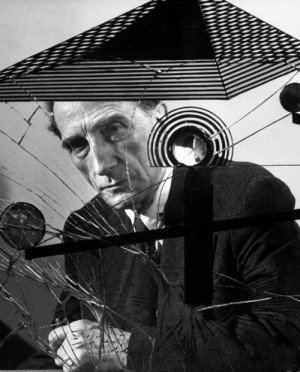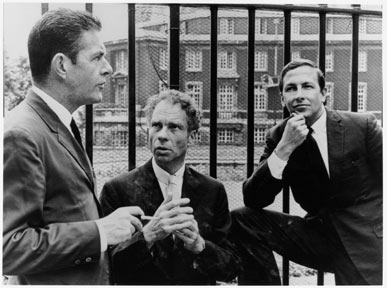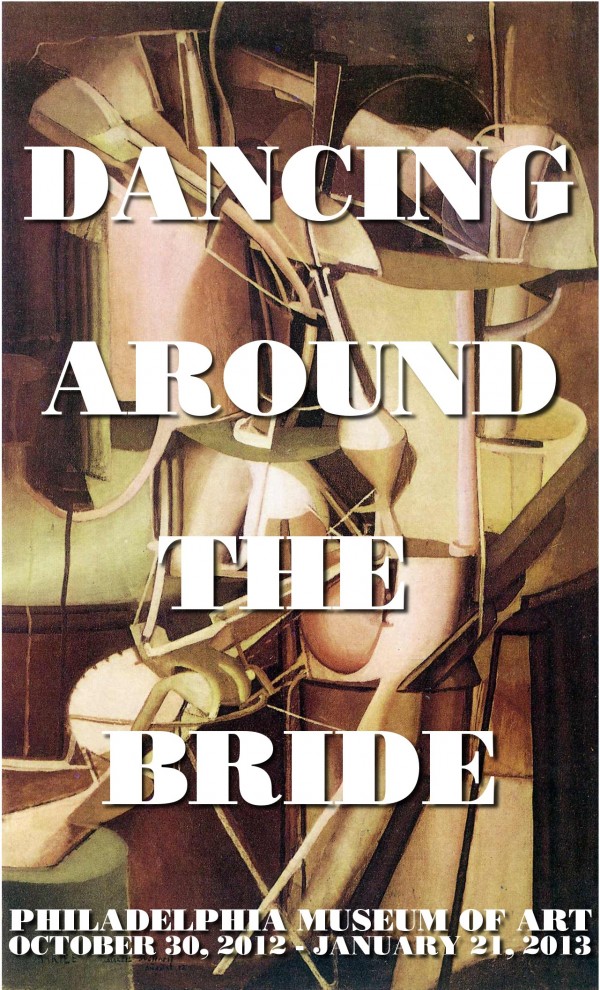 BY BRANDON LAFVING ARTS CORRESPONDENT The Philadelphia Museum of Art’s new exhibition, Dancing Around the Bride, courageously attempts to explain the work of Marcel Duchamp, one of the most important and enigmatic artists of the 20th Century, in terms that people who don’t have a Ph.D. in the meta mechanics of modernism can understand. Duchamp [PICTURED, BELOW RIGHT] re-imagined the definition of art — and more or less invented punk rock — when he entered a urinal as a piece for a museum exhibit and called it Fountain. It was the first of his series, entitled “readymades” and it started off the
BY BRANDON LAFVING ARTS CORRESPONDENT The Philadelphia Museum of Art’s new exhibition, Dancing Around the Bride, courageously attempts to explain the work of Marcel Duchamp, one of the most important and enigmatic artists of the 20th Century, in terms that people who don’t have a Ph.D. in the meta mechanics of modernism can understand. Duchamp [PICTURED, BELOW RIGHT] re-imagined the definition of art — and more or less invented punk rock — when he entered a urinal as a piece for a museum exhibit and called it Fountain. It was the first of his series, entitled “readymades” and it started off the Dada movement with a bang. Some despised fountain and thought it made a mockery of the art world — which is did. Others loved it and said that the series completely re-defined out collective understanding of what is and what isn’t art — which it also did. Either way, and for both better and worse, Fountain along with other Duchamp works, namely “The Large Glass,” gave rise to conceptual art.
Dada movement with a bang. Some despised fountain and thought it made a mockery of the art world — which is did. Others loved it and said that the series completely re-defined out collective understanding of what is and what isn’t art — which it also did. Either way, and for both better and worse, Fountain along with other Duchamp works, namely “The Large Glass,” gave rise to conceptual art.
A centerpiece of the museum’s world-renowned Duchamp collection, “The Large Glass” — a cryptic matrix of fuse wire, dust, and lead frozen, like an insect in amber, between two thick glass panels — is a lightning rod for some of Duchamp’s most profound ideas. Although the artist worked on the piece from 1915 to 1923, he kept insisting that it was “definitely unfinished.” Only after the glass was accidentally cracked during transport, then carefully repaired by the artist, was it deemed complete.
Years later, after Duchamp himself chose the piece’s location in the Philadelphia Museum of Art in 1953, the work inspired a new generation of Dada-influenced artists, specifically soon-to-be lionized painters like Jasper Johns and Robert Rauschenberg, avant-garde composer John Cage [PICTURED, BELOW LEFT] and choreographer Merce Cunningham. Dancing Around The Bride is a multi-media exhibit that attempts to explain, evoke and expand the creative dialog between these titans of 20th Centry art. Running concurrent with exhibit at PMA is Bowerbird’s BEYOND SILENCE, a month’s long series of concerts that bring to life many of Cage’s rarely performed pieces and combine them with Cunninham’s choreography in often unexpected settings (SEE the press release below for a complete listing of upcoming performances).
Dada showed that art did not need to be beautiful or intentional, that it can be flawed and accidental. Art exists, often elusively, somewhere in between the artist’s physical representation and the mind’s eye of the beholder. The element of chance, so central to Dadaism, often produces new opportunities to bridge the two that may well have never been discovered otherwise. Dancing Around The Bride attempts to expand the discovery  of these hidden connections and often exceeds any reasonable expectations of success.
of these hidden connections and often exceeds any reasonable expectations of success.
Even before you enter the exhibit, the curatorial team of Carlos Basualda, his assistant Erica Battle, and artist Philippe Parreno, attempts to provoke the same potentially frustrating, potentially laughable experience. Visitors enter the exhibit beneath a large white movie theater marquee. Large incandescent light bulbs dot its surface, which already seem out of place in a museum. Then the lights fade out, leaving the entire surface black. After an awkward and randomly timed pause, the light returns.
Other visceral cues and clues continue. The first thing you see is “The Bride,” an early painting that is a motley assemblage of industrial-looking panels and deconstructed mechanisms. Just beyond, the hallway opens into an enormous chamber with wiry sketchings hanging from the ceiling. Wooden chairs are turned to face or not to face the stage. Bicycle wheels add to the haphazard charm.
Dancing around the Bride tries to show AND tell with no small amount of tongue-in-cheek humor. Anyone interested may delve into any of a number of transparent drawers, which contain notes jotted down by the artists, including Duchamp’s off-the-cuff observations about chess (he was a member of the French national chess team, FYI) and the sheet music for original scores by Cage.
Prior to the exhibit, the Philadelphia Museum of Art already owned the most extensive Duchamp collection in the world, so the majority of the exhibits resources were spent on the packaging. Whether it works and what exactly it all means is, like beauty itself, in the eye of the beholder. Philippe Parreno reflected: “The work is very powerful, but it is also fragile… It depends on our attention.” Still, I couldn’t help thinking that if the greatest trick the devil ever played was to convince the world it didn’t exist, then Duchamp may have done the devil one better.
DANCING AROUND THE BRIDE WILL BE ON DISPLAY THROUGH JANUARY 21ST. PHAWKER HAS A LIMITED NUMBER OF TICKETS TO GIVE AWAY TO READERS. TO QUALIFY, JOIN OUR MAILING LIST AND THEN DROP US A NOTE AT FEED@PHAWKER.COM WITH YOUR NAME, MAILING ADDRESS AND MOBILE NUMBER FOR CONFIRMATION. SEE BELOW FOR A COMPLETE SCHEDULE OF THE CONCURRENT MULTI-MEDIA ‘BEYOND SILENCE’ FESTIVAL.
Cage: Beyond Silence continues with The Year Begins to be Ripe: Song Books, multiple takes on one magnum opus — Part two of John Cage festival runs Nov. 30-Dec. 9; Part three to run Jan. 11-20, 2013
PHILADELPHIA — In order to highlight the immense and open possibilities of John Cage’s compositions, part two of the Cage: Beyond Silence festival focuses entirely on one piece, Song Books (1970). The Year Begins to be Ripe: Song Books is part two of a major three-part festival celebrating the acclaimed musician and theorist’s myriad compositions; Cage: Beyond Silence, presented by Bowerbird in conjunction with the Philadelphia Museum of Art, runs through January 20, 2013.
As with many of Cage’s works, Song Books is indeterminate, or chosen by chance. Part two of Cage: Beyond Silence offers audiences a rare opportunity to experience multiple version of this work, further encouraging engagement with the ephemeral qualities of music that were so important to Cage. Two concert performances of Song Books, by Joan La Barbara’sNe(x)tworks (Nov. 30) and The BSC (Dec. 7), will present an intentional juxtaposition of styles and interpretations. These two groups will also each perform informally at the Philadelphia Museum of Art (Dec. 1 and 8, respectively), providing “sonic infiltration” to the festival’s partner exhibition,Dancing Around the Bride: Cage, Cunningham, Johns, Rauschenberg, and Duchamp (on view through January 21, 2013). Meanwhile, part two also includes an afternoon of workshops and hands-on activities (Dec. 2) as well as a performance of Cage’s Variations (Dec. 9), which foreshadowed Song Books, at West Philly’s Rotunda.
Says Rob Haskins, Cage scholar and associate professor of music at the University of New Hampshire: “One might think of Song Books as Cage’sArt of Fugue, an exhaustive demonstration of the diverse approaches to music-making that the composer had practiced over his long career. Of course, Cage — unlike J.S. Bach — continued his career for more than two decades after he completed the piece. But although he found new ways to extend his artistic vision in ways that surprised even him, he would only occasionally match the diversity and ambitious scope that he achieved so brilliantly in Song Books.”
Taking place at the Philadelphia Museum of Art and venues across the city,Cage: Beyond Silence is a three-part series that began in October: Part one,Move from Zero (Oct. 26-Nov. 4), focused on Cage’s early works and solos. Part three, At Least We Have Begun (Jan. 11-20, 2013), will juxtapose part two’s Song Books with the composer’s late-career meditative series Number Pieces (1987-92).
ABOUT SONG BOOKS
Replete with text and music materials quoted from Marcel Duchamp, Erik Satie, David Thoreau, Buckminster Fuller, Norman O. Brown, and even Mozart and Schubert, Song Books is a two-volume collection of 89 short solos. Some of these solos call for singing, conventional or otherwise; others require no singing at all, but rather reproduce the word-game actions of Cage’s Theater Piece (1960). Still other Solos are examples of another kind of theater altogether, one which clearly reflects the influence of the neo-Dadaist Fluxus movement. Instructions for some of these Solos ask the performer simply to “prepare something to eat” or to “perform a disciplined action that fulfills an obligation to others.”
Each realization of Song Books is performed to fill a predetermined duration, with any number of performers, each responsible for choosing their own music. Additionally, Cage indicated that a performance of Song Books may also include simultaneous performances of other indeterminate music such as Winter Music (1957), Concert for Piano and Orchestra (1958),Indeterminacy (1959), or Rozart Mix (1965).
SCHEDULE: PART TWO
(For tickets and information, visit cagebeyondsilence.com.)
SONG BOOKS IN CONCERT 1
Fri., Nov. 30, 8 p.m., $15
Christ Church Philadelphia, 20 N. American St.
The first of four realizations of Cage’s magnum opus Song Books, New York-based Ne(x)tworks (led by Joan La Barbara and including musicians Shelley Burgon, Yves Dharamraj, Miguel Frasconi, Stephen Gosling, Ariana Kim and Christopher McIntyre) will perform an ensemble-size, concert-length version at the historic Christ Church in Old City.
SONG BOOKS MINIATURES 1
Sat., Dec. 1, noon-4 p.m., free with museum admission
Philadelphia Museum of Art, 2600 Ben Franklin Parkway
Weaving through the Philadelphia Museum of Art’s Dancing Around the Bride exhibition, this performance of Song Books features short vignettes and tableaus performed by members of Ne(x)tworks.
BEHIND SONG BOOKS
Sun., Dec. 2, noon-4 p.m., free with museum admission
Philadelphia Museum of Art
2600 Ben Franklin Parkway
Talks, workshops and hands-on activities: Unpack Song Books with our expert guides, Joan La Barbara, Richard Kostelanetz and other guests. The beautiful score includes more than 90 solos exploring a wide range of notational systems, including pictures, maps and text.
SONG BOOKS IN CONCERT 2
Fri., Dec. 7, 8 p.m., $15
Philadelphia Episcopal Cathedral
3723 Chestnut St.
For the third interpretation of Song Books, The BSC (Bhob Rainey, soprano saxophone/director; Greg Kelley, trumpet; James Coleman, Theremin; Liz Tonne, voice; Chris Cooper, guitar and electronics; Vic Rawlings, cello and electronics; and Mike Bullock, bass) presents its own unique evening-length concert version, this time in the spacious Philadelphia Cathedral. The BSC is an ensemble recognized for the ability to push the boundaries of electro-acoustic sound production.
SONG BOOKS MINIATURES 2
Sat., Dec. 8, noon-4 p.m., free with museum admission
Philadelphia Museum of Art, 2600 Ben Franklin Parkway
The fourth and final version of Song Books brings the BSC’s members to the main stage of the Philadelphia Museum of Art’s Dancing Around the Bride exhibition for a series of intimate performances inspired by the backdrop of Rauschenberg’s Walkaround Time.
VARIATIONS
Sun., Dec. 9, 8 p.m., free
The Rotunda, 4014 Walnut St.
With vastly open and indeterminate scores and happenings, Variations I – VIII (1958-67) is a series of compositions that foreshadows both Song Books and the Fluxus movement performance pieces. Sometimes scored as broadly as “for any number of players and any sound producing means,”Variation IV includes 0’00”, Cage’s second version of 4’33”. Performers include Bonnie Jones, Maria Chavez, Nate Wooley, C. Spencer Yeh and more.
ABOUT BOWERBIRD
Situated at the forefront of artistic experimentation, Bowerbird is a Philadelphia-based nonprofit organization that presents music and interdisciplinary events by local and internationally recognized artists at a variety of venues across the region. The mission of Bowerbird is to raise the public’s awareness and understanding of provocative and divergent music traditions by providing numerous and diverse opportunities to directly experience the work of today’s leading artists. For more information, visit bowerbird.org.
Cage: Beyond Silence is made possible by The Pew Center for Arts & Heritage through the Philadelphia Music Project, The Presser Foundation, The Aaron Copland Fund for Music, Dina and Jerry Wind, and John J. Medveckis.

